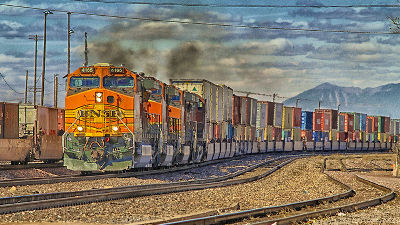What is the characteristic organizational chart created to process large-scale data in the telegraph era?

In modern times, gigabytes of data can be sent to the world over the Internet, but even telephones were not widespread in the 1850s, and letters and telegrams were common. In the 1850s, a railway company in New York used a 'characteristic organizational chart' to manage relatively large-scale data such as operation information of the entire railway line accurately and at high speed.
Big data in the age of the telegraph | McKinsey
The distinctive organizational chart was created in 1855 by Daniel McCallum, who was in charge of railroad operations at the New York and Erie Railroad. At that time, the New York and Erie Railroad owned the world's largest railroad, and due to the spread of telegrams, information such as accidents and delays was gathered at McCallum in near real time. However, that data exceeded the amount that McCallum could manage alone. Therefore, McCallum decided to create an organizational chart of the entire railroad and give multiple supervisors the authority to manage the information.
Below is the organization chart created by McCallum. Whereas a typical modern org chart is arranged from top to bottom in order of position, McCallum's org chart has management and supervisors at the bottom and employees on each line at the top.

McCallum empowered supervisors located at the bottom of the org chart to manage information on each line.

In McCallum's organizational chart, the rails of each line extend like branches, and the employees of each station are placed along the rails, with the management and supervisors as the roots. Also, people in moving occupations, such as drivers and conductors, are placed on winding lines.

McKinsey & Company said McKinsey placed management and supervisors at the bottom of the org chart: 'McKinsey called on railroad executives to support the railroad rather than directing it to run. According to one of McKinsey's key guidelines, 'appropriate division of responsibility,' the operation of each line was entrusted to the supervisor. '
McCallum also requires supervisors to report management-needed information to management while empowering supervisors to monitor information and make long-term decisions. Was there. In addition, McCallum has designed a system that can easily calculate the cost per mileage and the cost per vehicle. These efforts have enabled the New York and Erie Railroad to properly manage information.
McKinsey & Company points out that there are many leaders who are troubled by how to process a large amount of data even in the present age when the information processing ability has improved dramatically with the advent of computers. Even today, he claims that by empowering team members to manage information by following McCallum's organizational chart, opportunities to share information within the company will increase, and services and innovation can be improved.
Related Posts:
in Note, Posted by log1o_hf







